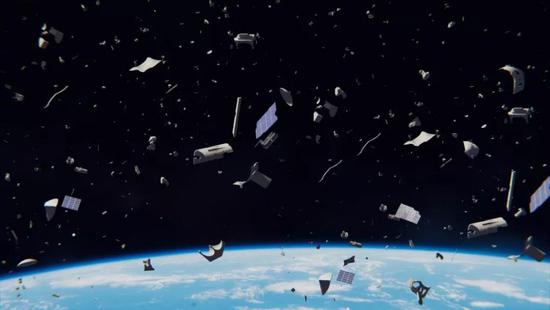A space debris removal satellite project called RemoveDebris (debris removal) passed key tests. The project satellite successfully penetrated the simulated debris in space with a harpoon-like device. It is reported that the project aims to clean up hundreds of thousands of pieces of space junk currently orbiting the earth. The test screen showed that the European satellite named RemoveDebris test-fired a barbed titanium spear the size of a writing pen on an aluminum panel attached to the satellite's short boom.
The harpoon-like device fired from a refrigerator-sized satellite at a speed of 44 miles per hour. It dragged a rope and punctured the aluminum panel violently.
"So far, we are really happy," said Guglielmo Aglietti, director of the Surrey Space Center in the United Kingdom and principal investigator of the $ 15 million project. "The target is made of the same material as the satellite, so it can represent the working principle of the entire system."
In the actual mission of clearing space debris, the satellite uses a much larger space harpoon to capture the debris and then drags it into the atmosphere to burn it. Agritti likened the exercise to the mission of the Expendables.
According to statistics, all kinds of space junk, from abandoned rocket parts and scrapped satellites to scattered nuts and bolts, are scattered in space. The U.S. Department of Defense now tracks more than 500,000 man-made debris accumulated in Earth orbit. All of this space debris poses a growing collision threat to passing spacecraft, such as the International Space Station and billion-dollar satellites.

"Statistically speaking, every five to nine years there will be a catastrophic collision, and a large space debris that is still intact will often be hit into thousands of debris," the German Aerospace Center specializes in handling space debris The expert Manuel Metz (Manuel Metz) said, "These new fragments may themselves create new collisions, and therefore will have a cascading effect." And this phenomenon is the 2013 movie "Gravity" Describe the potentially catastrophic phenomenon.
Agritti believes that it makes sense to focus on removing the largest space debris first, because they tend to be more threatening. The idea of ​​the entire project is to launch a series of garbage removal satellites to allow them to capture and remove some debris every year.
If the ongoing space debris removal test mission is successfully concluded, Agritti hopes that the aerospace company will be willing to provide funding for the task of removing space debris. "This is a proof of concept," he said. "If it succeeds, we hope that our industrial partners will advance it to the commercial sector."
This demonstration is the second in a series of tests conducted by the RemoveDebris satellite on space debris collection equipment. The RemoveDebris satellite was built by a consortium of universities and aerospace companies, mainly funded by the European Union.
Last September, the satellite successfully captured a piece of simulated debris using a spring-loaded net. In March of this year, the satellite will install an inflatable "towing sail" on a piece of space debris. Scientists expect that the "towing sail" will interact with a small number of air molecules at the altitude of the satellite, thereby slowing the flying speed of the debris, causing it to fall into the atmosphere and burn.
In addition, various potential devices have been proposed to capture and eliminate space debris, including self-propelled tethers and robotic arms. Agritti said that the reason for choosing harpoons, fishing nets and towing sails to remove space debris is because they are more economical.
Moriba Jah, a space scientist and space debris research expert at the University of Texas at Austin, said that it is best to have more than one way to remove all the accumulated garbage. "Actively removing space debris requires many different methods and techniques," he said in an email on Tuesday. "I think we need a so-called 'toolkit' that can apply various methods according to the actual situation."
Ultra Plantâ„¢ Grow Light offers One Chip Technology aimed to meet your indoor growing expectation such as improve plants' quality, increase yield, or better the margin, etc., all for helping you realize a higher return on your crops.
Ultra Plantâ„¢ Grow Light is combined our advanced All-In-One technology with patented optical design and customized light full spectrum supported from our experienced LED engineers, plant specialists and other partners working on horticulture.
From Ultra Plantâ„¢ APP, you are able to schedule the growing process including photoperiod, brightness and spectral in advance. The lighting system will help you grow smarter, easier and better.
Ultra Plantâ„¢ is the most versatile horticultural grow lighting fixture for indoor plants with flexible full spectrum, brightness control and uniform, wider light distribution, suitable for top lighting of all types of crops. No matter it applies to anywhere for any crop, Ultra Plantâ„¢ can do perfect work for you.
Full Spectrum Grow Light,Full Spectrum Led,Led Cob Full Spectrum,Best Full Spectrum Led Grow Lights
Feton Corporation , https://www.fetongrowlight.com